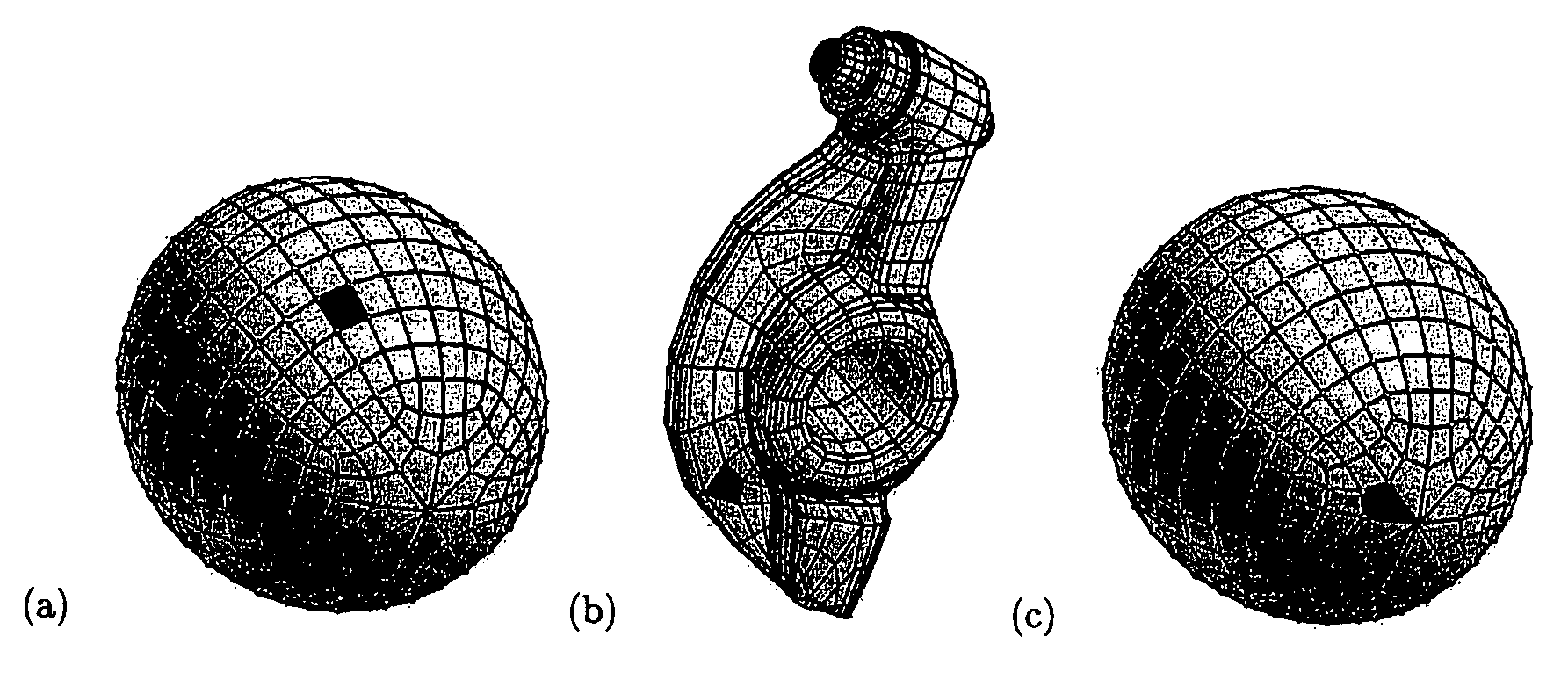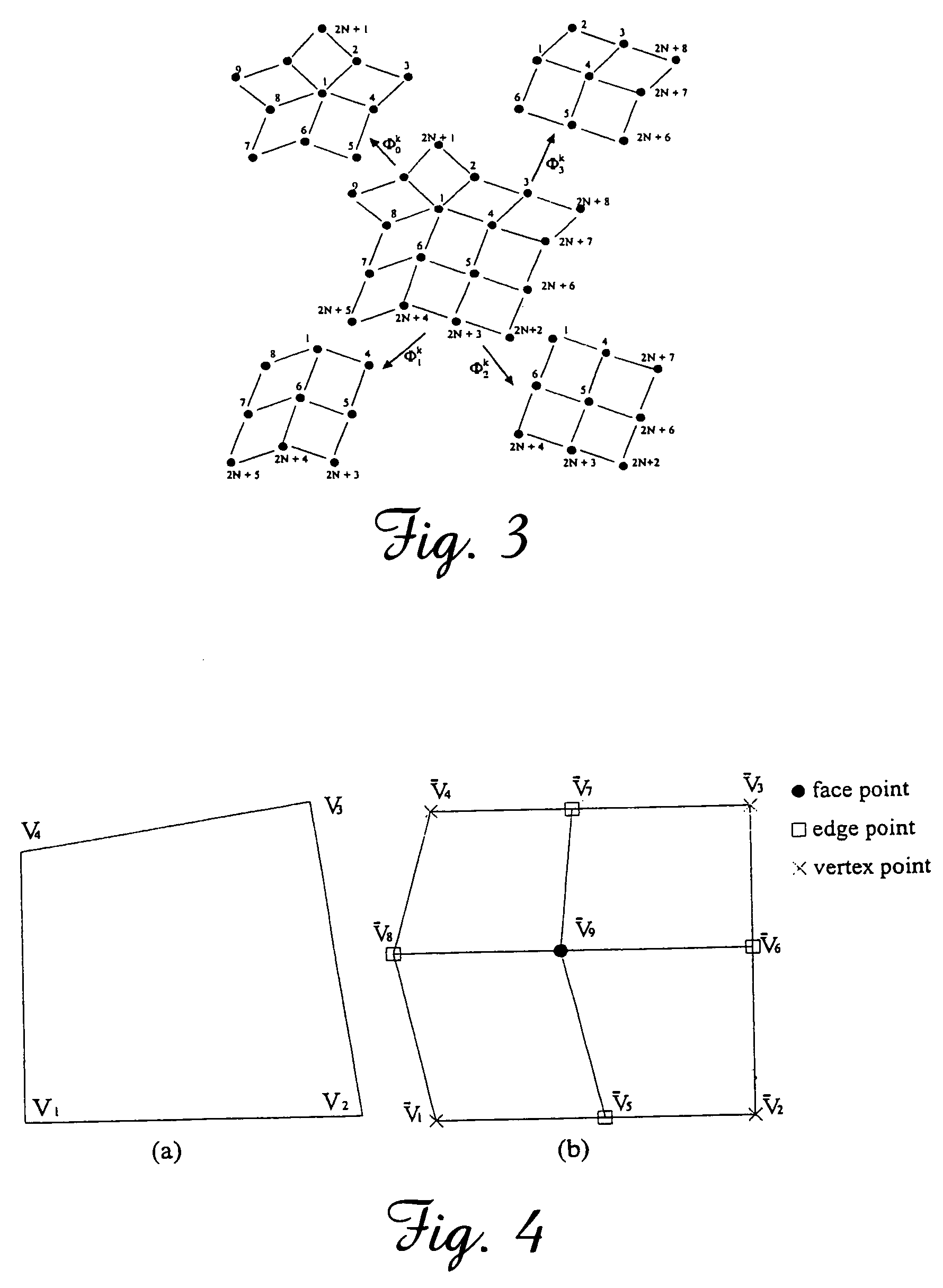Subdivision surface-based geometric modeling system
a geometric modeling and subdivision surface technology, applied in the field of images, can solve the problem of few suitable methods for dealing with precision/error control of subdivision surfaces
- Summary
- Abstract
- Description
- Claims
- Application Information
AI Technical Summary
Benefits of technology
Problems solved by technology
Method used
Image
Examples
example 1
[0091]Referring to FIG. 6, distance and subdivision depth computation for a CCSS patch was calculated for several surfaces. The distances between the faces of the control meshes and the corresponding limit surface patches for each mesh face were 0.034 (FIG. 6a), 0.25 (FIG. 6b), and 0.15 (FIG. 6c). For an error tolerance of 0.01, the subdivision depths computed for each mesh face was 1 (FIG. 6a), 24 (FIG. 6b), and 22 (FIG. 6c). The calculated subdivision depths for the mesh faces shown in FIGS. 6b and 6c were greater because each surface has an extraordinary vertex. For the mesh face shown in FIG. 6b, subdivision depths for error tolerances 0.25, 0.2, 0.1, 0.01, 0.001, and 0.0001 were 1, 3, 9, 24, 40, and 56, respectively.
example 2
[0092]FIGS. 7, 8, and 9 compare conventional uniform Catmull-Clark subdivision with the adaptive subdivision method of the present invention. Referring to FIG. 7 showing a rocker arm, uniform Catmull-Clark subdivision resulted in 22,656 vertices, 45,312 edges, and 22,656 faces (FIG. 7c) for an error of 0.25. In contrast, the adaptive subdivision method of the present invention (FIG. 7d) generated 2,706 vertices, 5,412 edges, and 2,706 faces, i.e. only 3 / 25 of the total vertices, edges, and faces required for conventional Catmull-Clark subdivision. Lowering the error tolerance to 0.2 resulted in a maximum subdivision depth of 4. In this latter case, uniform Catmull-Clark subdivision generated 362,496 vertices, 724,992 edges, and 362,496 faces. In comparison, the label-driven adaptive subdivision method of this invention generated only 9,022 vertices, 18,044 edges, and 9,022 faces, or a 40× improvement on the total number of vertices, faces, and edges.
[0093]FIG. 8 depicts a ventilatio...
case 1
[0098](E-F-E):consider2V0,2i+1-V0,3i+1-V0,1i+1.2V0,2i+1-V0,3i+1-V0,1i+1=116(2V0,2i-V0,3i-V0,1i+2V0,1i-V0,2i-V0,0i+2V1,2i-V1,3i-V1,1i+2V1,1i-V1,2i-V1,0i)≤116M0,0i+116M0,0i+116M0,0i+116M0,0i=14M0,0i.(39)
PUM
 Login to View More
Login to View More Abstract
Description
Claims
Application Information
 Login to View More
Login to View More - R&D
- Intellectual Property
- Life Sciences
- Materials
- Tech Scout
- Unparalleled Data Quality
- Higher Quality Content
- 60% Fewer Hallucinations
Browse by: Latest US Patents, China's latest patents, Technical Efficacy Thesaurus, Application Domain, Technology Topic, Popular Technical Reports.
© 2025 PatSnap. All rights reserved.Legal|Privacy policy|Modern Slavery Act Transparency Statement|Sitemap|About US| Contact US: help@patsnap.com



